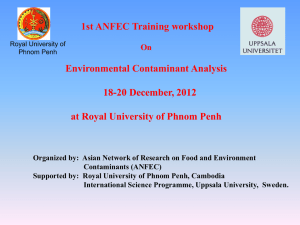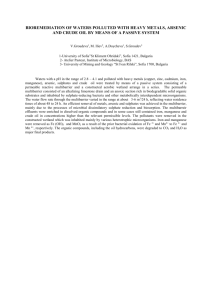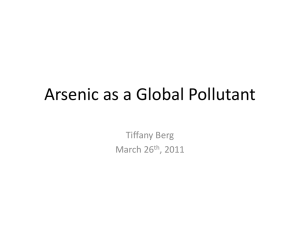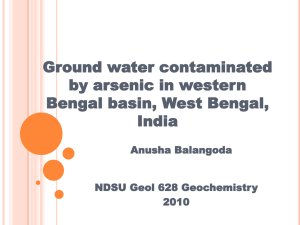A guide to arsenic pollution of groundwater in Bangladesh and West
advertisement
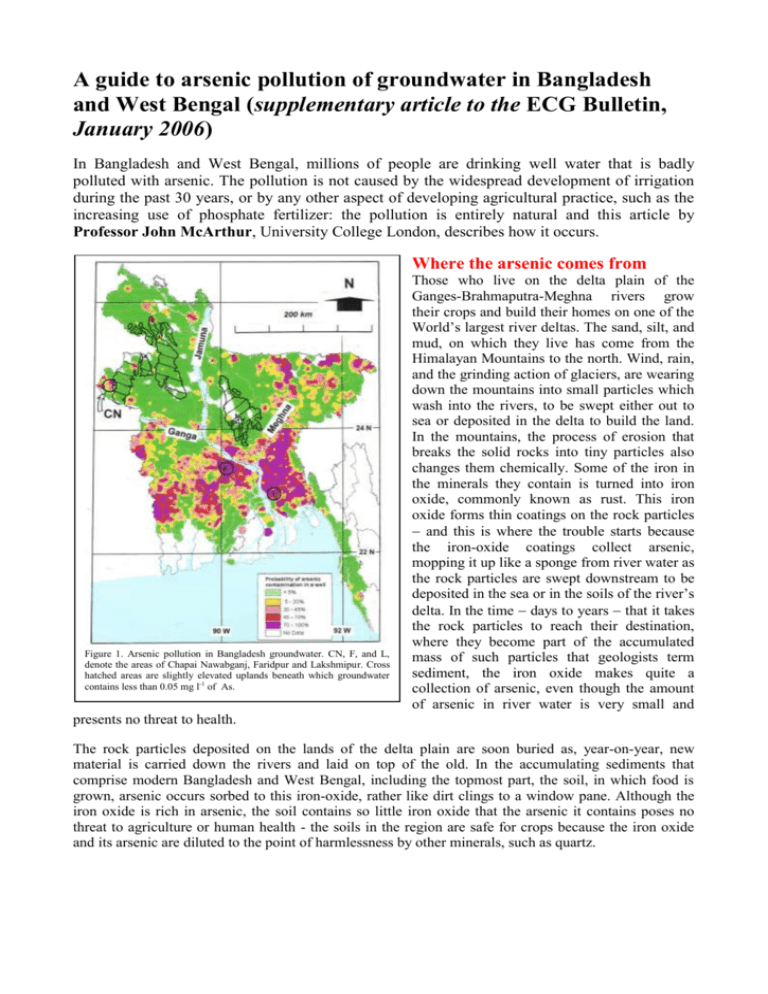
A guide to arsenic pollution of groundwater in Bangladesh and West Bengal (supplementary article to the ECG Bulletin, January 2006) In Bangladesh and West Bengal, millions of people are drinking well water that is badly polluted with arsenic. The pollution is not caused by the widespread development of irrigation during the past 30 years, or by any other aspect of developing agricultural practice, such as the increasing use of phosphate fertilizer: the pollution is entirely natural and this article by Professor John McArthur, University College London, describes how it occurs. Where the arsenic comes from Figure 1. Arsenic pollution in Bangladesh groundwater. CN, F, and L, denote the areas of Chapai Nawabganj, Faridpur and Lakshmipur. Cross hatched areas are slightly elevated uplands beneath which groundwater contains less than 0.05 mg l-1 of As. Those who live on the delta plain of the Ganges-Brahmaputra-Meghna rivers grow their crops and build their homes on one of the World’s largest river deltas. The sand, silt, and mud, on which they live has come from the Himalayan Mountains to the north. Wind, rain, and the grinding action of glaciers, are wearing down the mountains into small particles which wash into the rivers, to be swept either out to sea or deposited in the delta to build the land. In the mountains, the process of erosion that breaks the solid rocks into tiny particles also changes them chemically. Some of the iron in the minerals they contain is turned into iron oxide, commonly known as rust. This iron oxide forms thin coatings on the rock particles and this is where the trouble starts because the iron-oxide coatings collect arsenic, mopping it up like a sponge from river water as the rock particles are swept downstream to be deposited in the sea or in the soils of the river’s delta. In the time days to years that it takes the rock particles to reach their destination, where they become part of the accumulated mass of such particles that geologists term sediment, the iron oxide makes quite a collection of arsenic, even though the amount of arsenic in river water is very small and presents no threat to health. The rock particles deposited on the lands of the delta plain are soon buried as, year-on-year, new material is carried down the rivers and laid on top of the old. In the accumulating sediments that comprise modern Bangladesh and West Bengal, including the topmost part, the soil, in which food is grown, arsenic occurs sorbed to this iron-oxide, rather like dirt clings to a window pane. Although the iron oxide is rich in arsenic, the soil contains so little iron oxide that the arsenic it contains poses no threat to agriculture or human health - the soils in the region are safe for crops because the iron oxide and its arsenic are diluted to the point of harmlessness by other minerals, such as quartz. Buried swamps are the key to arsenic pollution When sediment is buried, the iron oxide and its load of arsenic is stable if rainwater percolates downward through the sediment from the surface carrying in it a small amount of oxygen, dissolved from the air through which the rain fell. Small though the amount may be, it is enough to remind the iron oxide of the conditions under which it travelled from the mountains, which was in river water containing a small amount of dissolved oxygen derived from the atmosphere. It is this oxygen that maintains the iron oxide in a stable state, clinging firmly to its arsenic. Unfortunately, lurking in the subsurface of many deltas in Asia are ancient buried wetlands containing peat, a material composed mostly of dead vegetation, and other sediment types also rich in organic matter. The organic matter is there because the delta has a hot and wet, monsoonal, climate, and had such a climate in ancient times. Consequently, swampy conditions allow wetland vegetation to flourish. It was particularly prevalent about 5000 years ago, when wetlands were not only more widespread in the Ganges Plain than they are now, but were also widespread across other Asian deltas, such as the Mekong River. And the organic matter in these wetlands is the key to understanding arsenic pollution of groundwater because, the organic matter buried in them makes the iron oxide unstable. The organic matter in these ancient buried wetlands is slowly rotting, just as do grass cuttings in a compost-heap. The decomposition occurs because bacteria are eating the organic matter and turning it into carbon dioxide and body material. To make this process work they need oxygen. Humans survive the same way, but we take our organic matter in a more palatable form, such as rice, fish, or meat, and we take oxygen in through our lungs to drive our metabolization of this food. The bacteria in the ground are entirely natural and pose no threat to health - they are firmly attached to their source of food (Figure 2) and on it they stay, reluctant to let go and be carried away to starvation by the slow Figure 2. How pollution occurs: from THES, 22/12/2000, with permission. percolation of the surrounding water in the sediment, rather like beggars at a banquet, who have no intention of leaving while there is food on the table. Bacterial decay causes mobilization of arsenic The bacteria that are decomposing the subsurface organic matter beneath Bangladesh and West Bengal (by eating it) come in many different forms. Those very close to the surface, like humans, can consume the organic matter only if they have available free oxygen from the atmosphere to drive their metabolism; they obtain the oxygen from the small amounts of oxygen dissolved in rainfall that percolate into the sediments. But these bacteria consume all the atmospheric oxygen that comes their way; their cousins that live deeper in the sediment must live without atmospheric oxygen and these deep-dwellers have grown so used to being deprived of it that they have even come to dislike it as being too rich a dietary supplement. They now prefer to take their oxygen from other sources, and therein lies another part of the arsenic problem. The only other viable source of oxygen available to the deep-dwelling bacteria is the oxygen in iron oxide. Despite the fact that this oxygen already chemically combined with the iron, the microbes wrench out the oxygen and use it to drive their metabolization of the organic matter. They expend a great deal of energy undertaking this chemical conversion, so they live at a slow pace – fighting iron for its oxygen is not very rewarding. The bacteria have no use for the iron in the iron oxide, or for the arsenic that was clinging to; both are ejected from the bacterial cell as waste, only to accumulate in the water and poison its unsuspecting consumers. Which is why groundwater beneath the delta plain is so rich in both dissolved iron and dissolved arsenic, and why it is often also rich in other products that result from the decay of organic matter, such as phosphorus, ammonia, and methane. Arsenic is found in the water because it is a waste product of the bacterial metabolization of organic matter. The patchy distribution of arsenic in groundwater, seen in small scale in the map of arsenic pollution (Figure 1), therefore reflects the geographical distribution of buried organic matter, notably peat and similar swampland vegetation. The depth at which large amounts of organic matter exists is shown by the vertical distribution of arsenic in the aquifers; in many areas of the Ganges Plain (Figure 1), concentrations of arsenic in the groundwater increase with depth to a maximum around 20 to 40 metres before decreasing again with further increase in depth: in Chittagong District, which is in south-eastern Bangladesh (the area around the L on Figure 1), the arsenic maximum is found at a depth of around 20 metres (Figure 3). 0 20 Depth m A curious fact, and one that is counter-intuitive, 40 follows from knowing the lateral and vertical 60 distribution of arsenic; the distribution of arsenic 80 pollution has little to do with the distribution of 100 arsenic and iron oxide in the sediment and everything 120 to do with the distribution of buried decaying 0 200 400 600 800 1000 1200 vegetation. Iron oxide and arsenic are found Arsenic, microgrammes per litre everywhere in the soils and sediment of the delta plain, but buried organic matter is not. Rather like a Figure 3. How arsenic concentrations change with depth in District, in the southeast of Bangladesh. Similar car that can go nowhere without petrol, iron oxide is Chittagong distributions with depth are seen in other arsenic-polluted areas. not broken up by bacteria to release iron and arsenic unless organic matter is available to fuel the process. Where there is no buried organic matter there are few bacteria, so rain water percolating into the ground retains its dissolved oxygen and, in its presence, iron oxide remain stable, holding tightly to its arsenic. The main regions in the delta where this occurs are the slightly elevated (20 metres above sea level) uplands to the north of Dhaka (Madhupur Tract) and in the northwest of Bangladesh on the border with West Bengal (Barind Tract), but there are other areas, as the map shows, where arsenic is not a problem in groundwater. Does buried organic matter cause arsenic pollution anywhere else? Where else in the world might groundwater suffer from severe arsenic pollution because of large amounts of buried organic matter, as happens in Bangladesh and West Bengal? Vulnerable regions include the deltas of tropical rivers, such as the Mekong, Red, Irrawaddy, and Chao Phraya rivers, the northern coastal plains of Java and Sumatra, and the broad low-lying valleys of major rivers, where natural barriers to flow give rise to thick accumulations of sediment that may have hosted wetlands in past times. Buried organic matter (even peat) is almost certainly the root cause of arsenic pollution in northeast and southwest Taiwan, the Red River Basin of Vietnam around Hanoi, the Great Bend Basin of the Yellow River in China, and the upper Mekong River in Cambodia. Signs of the process are not just that the water is rich in arsenic, but that it is usually rich in dissolved iron, ammonium, phosphate and, sometimes, methane, a gas that can burn (so one quick way of assessing areas at risk might be to ask villagers whether they can burn their well). As many lowland plains are centres of agriculture and urbanization, such areas are very susceptible to harm from arsenic pollution. Bibliography (downloadable from the London Arsenic Group on http://www.es.ucl.ac.uk/research/lag/as/) J.M. McArthur, D.M. Banerjee, K.A. Hudson-Edwards, R. Mishra, R. Purohit, P. Ravenscroft, A. Cronin, R.J. Howarth, A. Chatterjee, T. Talukder, D. Lowry, S. Houghton and D.K. Chadha (2004). Natural organic matter in sedimentary basins and its relation to arsenic in anoxic ground water: the example of West Bengal and its worldwide implications. Applied Geochemistry, 19, 1255–1293. P. Ravenscroft, J.M. McArthur and B. Hoque (2001). Geochemical and palaeohydrological controls on pollution of groundwater by arsenic. Arsenic Exposure and Health Effects IV. W.R. Chappell, C.O. Abernathy & R. Calderon (Eds), 53-77, Elsevier Science Ltd. Oxford. J.M. McArthur, P. Ravenscroft, S. Safiullah and M.F. Thirlwall (2001). Arsenic in groundwater: testing pollution mechanisms for aquifers in Bangladesh. Water Resources Research, 37, 109-117. R. Nickson, J.M. McArthur, P. Ravenscroft, W.G. Burgess, and M. Ahmed (2000). Mechanism of arsenic release to groundwater, Bangladesh and West Bengal. Applied Geochemistry, 15, 403-411. R. Nickson, J. McArthur, W. Burgess, M. Ahmed, P. Ravenscroft and M. Rahman (1998). Arsenic poisoning of groundwater in Bangladesh. Nature, 395, 338. John McArthur, Professor of Geochemistry and Graduate Tutor Earth Sciences, University College London, Gower Street, London WC1E 6BT Home page www.es.ucl.ac.uk/people/mcarthur/ London Arsenic Group www.es.ucl.ac.uk/research/lag/as/

